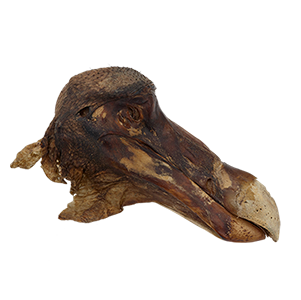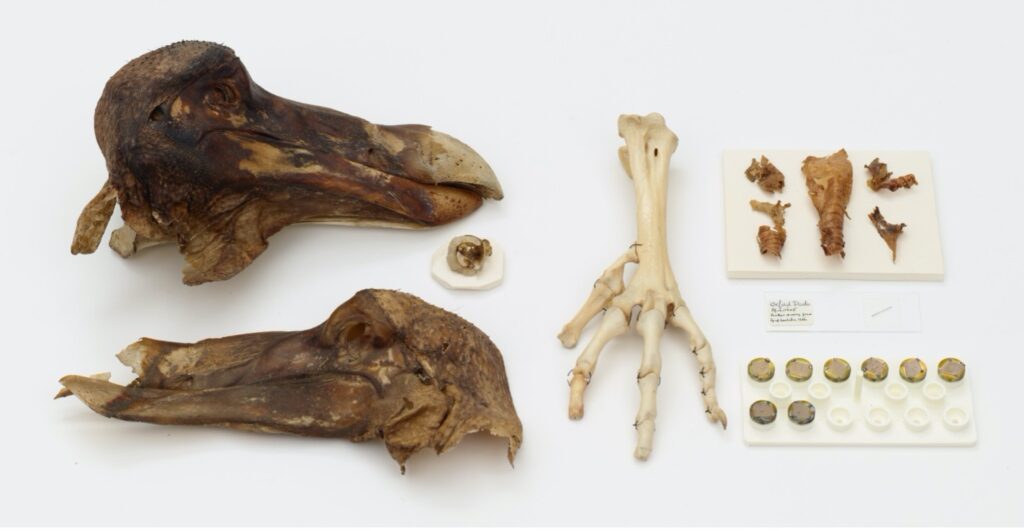 Not every remnant of past food preserved in scientific collections is, or historically was, enticing. This famed artifact, known as the Oxford Dodo, is the only remaining specimen of the extinct bird to still retain some of its skin—in this case, capping its unappetizing skull. That it is potentially a food object is not readily apparent at first gruesome glance.
Not every remnant of past food preserved in scientific collections is, or historically was, enticing. This famed artifact, known as the Oxford Dodo, is the only remaining specimen of the extinct bird to still retain some of its skin—in this case, capping its unappetizing skull. That it is potentially a food object is not readily apparent at first gruesome glance.
A dodo’s anatomy is best marked by its limitations on flight: short wings and a delicate tail ensure the species is, above all, strikingly antithetical to the idea of a bird, if still technically resemblant of one. So wrote ornithologist Hugh Edwin Strickland and anatomist Alexander Melville in the 1848 tract The dodo and its kindred:
“There appear … reasonable grounds for believing that the Creator has assigned to each class of animals a definite type or structure from which He has never departed… and [in] the Dodo, [certain] organs are merely suppressed, and not wholly annihilated.”
First discovered in the sixteenth century, dodos lived exclusively on the then-uninhabited island of Mauritius in the Indian Ocean. For mariners who would land at Mauritius during the coming century, the dodo disappointed with regard to both economic and alimentary trade value. Its downy plumage was in no way considered decoratively, texturally, or colorfully attractive to an existing market. Moreover, shipmen grieved the dodo’s unpalatability as a food that often made up a significant portion of provisions. Dutch sailors called them Walckvogel (meaning disgusting bird) for their tough flesh, not even softened by boiling. Ironically, for a bird rejected as inedible, the dodo found resonance as a European symbol of gluttony. In addition to its stubborn flesh, the dodo’s physical ugliness and allegedly greedy feeding habits made it the perfect candidate for such an emblem. Historian Natalie Lawrence notes that the dodo became a creature “imbued with the moral overtones of the consumptive enterprise” of the Dutch East India Company, in particular.
For an animal of minimal inherent value to humans in the seventeenth century, the sequence of events in the Oxford specimen’s life and death are charged with intrigue. The bird, whose precise origins and date of death remain unknown (but whose demise was apparently achieved by a gunshot to the head), ended up in the Tradescant collection that later became part of the Ashmolean Museum, now housed at the University of Oxford. The specimen’s preserved form offers more culinary questions than answers.

While it was long believed that museum staff dramatically cast the long-dead dodo into a 1755 fire, with only the head and feet heroically salvaged from the flames, the more likely scenario, according to Malgosia Nowak-Kemp and Julian Hume, is that the rest of the specimen’s progressively decaying body was disposed of in accordance with the Ashmolean’s original governance and maintenance rules. Whatever the true reason for the bird’s fragmented state, the sectioning of the specimen’s body recalls a cooking preparation rather than typical scientific preservation. In the hands of a butcher, a bird’s head and feet are removed from the meat of the body. The Oxford Dodo’s head seems observably picked of its feathers, like a bird plucked for table; many holes that would have held the shaft of a feather are empty. Moreover, the Ashmolean today describes the bird’s remains as “mummified.” Animal mummification involved the use of salts and spices; in the sense that the remaining skin is maggotless and relatively undecayed, well-established bird preservation techniques like salting and smoking and potash rubbing may have been implemented soon after the dodo’s death, turning it into a kind of jerky. Indeed, the various techniques used by scientists to embalm the specimen over the years resemble the tools of cookery as much as those of natural history. Might someone, at some stage, have been planning to turn this bird into a meal? Or, on the flipside, could the miraculous survival of this skin despite all odds testify to the fact that few ever wanted to eat the flesh of this fowl in the first place?
While the answers to those and many other questions about the specimen remain unknown, appetites ultimately sealed the fate of the dodo as a species, which did not survive the seventeenth century. The consumptive urges of empire and natural history often led to the extinction of wildlife. Voyagers released animals like dogs, pigs, and rats onto the dodo’s island. These voracious mammals drove dodos to non-existence by eating their eggs and young. The species became one of the most famous cases of human-induced extinction. Given that the “jerky” on this specimen’s skull constitutes the only extant soft tissue of the fabled dodo, it is a holy grail for researchers today—and the artifact even raises a dream of possible species resurrection to scientists, as it harbors genetic material. But that persistent skin evokes a different, gustatory story, too.
To tell the history of food and science together, we must also heed those past repasts both relished and rejected. Once a loathsome bird, the dodo continues to come to light as an object of desire both cultural and culinary.
Image: The Oxford Dodo. © Oxford University Museum of Natural History.
 This article was written by C.C. Lucas. For more information about her work and her other contributions to The Kitchen in the Cabinet click here.
This article was written by C.C. Lucas. For more information about her work and her other contributions to The Kitchen in the Cabinet click here.
References
Lawrence, Natalie. “Assembling the Dodo in Early Modern Natural History.” The British Journal for the History of Science 48, no. 3 (2015): 387–408.
McCarthy, Erin. “Head Case: What the Only Soft Tissue Dodo Head in Existence Is Teaching Scientists About These Extinct Birds.” Mental Floss. February 23, 2018. https://www.mentalfloss.com/article/531578/head-case-what-only-soft-tissue-dodo-head-existence-teaching-scientists-about-these-extinct-birds.
Nowak-Kemp, M. and J.P. Hume. “The Oxford Dodo. Part 1: The Museum History of the Tradescant Dodo: Ownership, displays and Audience.” Historical Biology 29, no. 2 (2017): 234–247.
Parish, Jolyon C. The Dodo and the Solitaire: A Natural History. Bloomington & Indianapolis: Indiana Press, 2013.
Poliquin, Rachel. The Breathless Zoo: Taxidermy and the Cultures of Longing. University Park: The Pennsylvania State University Press, 2012.
Strickland, Hugh Edwin and Alexander Gordon Melville. The dodo and its kindred; or, The history, affinities, and osteology of the dodo, solitaire, and other extinct birds… London, 1848. 15.